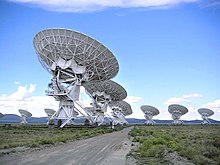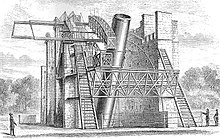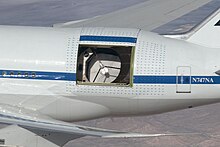telescope


A telescope is an instrument that collects and bundles electromagnetic waves in order to be able to observe distant objects. The expression formed from the Greek τῆλε téle ("far") and σκοπεῖν skopeín ("observe, spy out") was first coined in modern times, but the ancient Greek word τηλεσκόπος teleskópos ("far-sighted").
About the term telescope
In addition to optical astronomy (visible light, UV and infrared ), the term telescope is also used for X-ray and radio radiation . Also optical but not further serve assemblies as an optical telescope are established, the observation items are designated as such. Such a telescope can be used, for example, to expand the beam (enlarging the beam diameter) of lasers in order to be able to transmit the beam over longer distances or to reduce its intensity .
Telescope is occasionally further generalized to arrangements of particle or radiation detectors that are direction- sensitive, i.e. allow a reconstruction of the direction of incidence of the detected radiation (see detector telescope ). An example of this is the term neutrino telescope , which is sometimes used in the literature.
History of Optical Telescopes
The first telescopes were telescopes with lenses . The first telescope is the Galileo telescope , invented in 1608 and further developed by Galileo Galilei from 1610 . The sharper Kepler telescopes were designed a few years later, but the more powerful and color-pure lenses were not designed until 1770.
When the lens telescopes with the giant telescopes up to 20 meters long reached their limits around 1900 , the development shifted to the more compact mirror telescopes , which today reach 8 to 10 meters in diameter. Their prototypes - the Cassegrain and Newton telescopes - were made around 1670. The modern space telescopes also observe in the UV and infrared , while the radio telescopes on the ground are being expanded into large, area-wide antenna systems.
From Galilei and Kepler telescopes to achromatic lenses
The Galileo telescope is considered to be the first telescope . It is also called the Dutch telescope . It was invented by the Dutch eyewear maker Hans Lipperhey around 1608 and further developed by Galileo Galilei in the following years .
According to Pierre Borel , Zacharias Janssen and his father are said to be the real inventors (1610) and Hans Lipperhey only built a telescope after hearing about Janssen's invention.
The Kepler telescope ( astronomical telescope ), which was designed by Johannes Kepler in 1611 and realized in 1613 by the Jesuit Christoph Scheiner , had a sharper image and a larger field of view . In order to reduce the chromatic aberration , very long focal length lenses were initially used . More compact and more powerful telescopes were only available when the achromatic lenses were invented around 1750 . Nevertheless, it took a few decades until Josef Fraunhofer was able to manufacture lenses with openings over 30 cm around 1825. In the meantime, the slightly more powerful reflector telescopes were used for faint celestial objects such as nebulae or galaxies , but their metal mirrors were very heavy and required greater precision .
First mirror telescopes
The first of these reflecting telescopes were designed in the 1630s, but had major imaging errors due to the tilted main mirror . They were not significantly improved until 1663 by James Gregory and in 1672 by Laurent Cassegrain and Isaac Newton . These types of Cassegrain and Newton telescopes , which are still used today , became prototypes of the further development that began around 1900.

In terms of size, it peaked in 1845 with Lord Rosses 16-meter-long Leviathan , whose 1.83-meter-tall metal mirror alone weighed 3.8 tons. With this - admittedly difficult to use - instrument, the wealthy amateur astronomer was able to recognize the spiral structure of some galaxies for the first time, but no specialist astronomer believed him at the time.
When Fraunhofer's successors had better types of glass and casting methods at their disposal, larger and larger lens telescopes were built in the 1870s . The Nice Observatory started with a 26-inch lens (65 cm), with which Schiaparelli's Martian channels were confirmed by other astronomers for the first time . 1877 was followed by the Vienna University Observatory with the Grubb 'rule 68-cm refractor, the St. Petersburg by 5 cm surpassed little later. While in the following years even larger lenses increased the selectivity, the glass casting for 1-meter mirrors was also developed in favor of the light intensity.
Astrophysics and large telescopes
With the advent of astrophysics is called designed Doppelrefraktoren that visually -spektrografisches and photographic could combine observation. In Paris and Potsdam such refractors with 80/60 cm aperture were built in 1893/99 and the soaring of spectroscopy began. But when the Lick and Yerkes observatory even installed telescopes with lenses of 91 and 102 cm in the USA , the optical-mechanical limits had been reached: the lens deflection destroyed further increases in light intensity and resolution, and the mounts of these dozen tons heavy monsters were extremely complex, since lenses, unlike mirrors, can only be grasped at the edge.
Therefore, the further development went back to the mirror telescopes , for which suitable processes for glass casting had been developed since around 1900 . The greatest progress was brought about by the 2.5-meter Hooker telescope on Mount Wilson , with which the edge of the Andromeda Nebula could be resolved into individual stars for the first time and spectroscopy was also possible very distant objects. It received a stable frame mount , as did the 5-meter telescope from Mount Palomar in 1947 . This remained the world's largest telescope for 30 years. The 6-meter mirror, cast in 1975 for the Russian town of Selentschuk , was the last of its kind - it was already showing significant deflections - and so the large telescopes of the 1980s switched to segmented mirrors. Most of these modern instruments are designed according to the Ritchey-Chretien system developed around 1970 .

Today (beginning of the 21st century) there are already several mirror telescopes in the 8 to 10 meter class whose active optics stabilize the mirror shape. The deformation due to the variable telescope inclination is also corrected. In addition, the newly developed adaptive optics reduce the influence of air turbulence . For around 2025, ESO is planning the 30-meter " European Extremely Large Telescope " (E-ELT), which will be nine times more powerful than today's 10-meter mirrors.
When the lens telescopes with the giant telescopes up to 20 meters long reached their limits around 1900 , the development shifted to the more compact mirror telescopes , which today reach 8-10 meters in diameter. Their prototypes - the Cassegrain and Newton telescopes - were made around 1670. The modern space telescopes also observe in the UV and infrared range, while the radio telescopes on the ground are being expanded into large, area-wide antenna systems.
Types of telescopes
Depending on the frequency spectrum or wavelength range of the electromagnetic radiation, one differentiates:
- Gamma telescopes
- X-ray telescopes
- optical telescopes ( telescopes and reflector telescopes )
- Infrared telescopes
- Radio telescopes .
Apart from the space telescopes , they are dependent on the wavelengths of the astronomical window , in which the radiation from the earth's atmosphere is little or no absorption. A location as high as possible and with a dry climate is an advantage.
In order to be able to point telescopes at an astronomical object , they are usually attached to a mount . Exceptions are fixed large telescopes such as the Arecibo Observatory or space telescopes, which are positioned differently.
There is a wide range of telescope accessories (see below), from filters to a wide variety of eyepieces .
Alignment of a telescope
The four degrees of freedom of a telescope are:
Modern hexapod telescopes can be aligned freely in all three spatial directions with the help of linear actuators .
Special designs
- Tower telescope
- Giant telescope
- Schiefspiegler
- Telescopes for airborne astronomy
- Liquid mirror telescopes
Major telescopes
Visible Light Telescopes (Optical Telescopes)
The currently largest optical telescopes with primary mirror diameters over 8 meters are:
- the two Keck telescopes of the Mauna Kea Observatory
- the four telescopes of the Very Large Telescope (VLT) in the Atacama Desert in Chile
- the Gemini telescopes in Hawaii and Chile
- the Subaru telescope in Hawaii
- the Hobby Eberly Telescope in Texas
- the Southern African Large Telescope (SALT) in South Africa
- the Gran Telescopio Canarias on La Palma
- the Large Binocular Telescope (LBT) in Arizona.
Larger telescopes such as the European Extremely Large Telescope or the Giant Magellan Telescope are in planning.
The Hale Telescope on Mount Palomar in California was historically significant .
Other telescopes are listed in the optical telescope and ground-based observatory categories as well as in the list of the largest optical telescopes .
Radio telescopes
Space telescopes
Use of the primary image
Visual observations with smaller telescopes are performed using an eyepiece that is placed behind the focus. Commercially available small or medium format cameras or electronic sensors can be used here. With large telescopes there are various additional devices such as spectrographs, photometers or cameras at this point.
Large telescopes use the focus of the main mirror (the primary focus) for direct observations. For this, some telescopes have a primary focus cabin that replaces the secondary mirror. Before the introduction of electronic detectors, an astronomer stayed there for the entire observation program, today only the instrument is mounted there and controlled from the control room. Other large telescopes direct the primary image from the main optics via a Coudé beam path or via optical glass fibers into their own evaluation room. This enables the use of large analysis devices, the weight of which would otherwise complicate the construction of the movable assembly of the main optics.
Telescope accessories
See also
- First Light (Engl. Firstlightdesign )
- Day observation
- Amateur Telescope Making
- Satellite telescope
literature
- Günter D. Roth : history of astronomy (astronomers, instruments, discoveries). Kosmos-Franckh, Stuttgart 1987, ISBN 3-440-05800-X .
- Schilling, Govert / Christensen, Lars Lindberg: Our window to space - 400 years of discoveries with telescopes. Wiley-VCH, Berlin 2008. ISBN 978-3-527-40867-2 .
- Ulf Borgeest: Europe's new telescopes. Stars and Space Publishing House, Heidelberg 2003, ISBN 3-936278-47-4 .
- Jingquan Cheng: The Principles of Astronomical Telescope Design. Springer, Berlin 2009 ISBN 978-0-387-88790-6 .
- Patrick McCray: Giant telescopes - astronomical ambition and the promise of technology. Harvard Univ. Press, Cambridge 2004, ISBN 0-674-01147-3 .
- Joanna Mikolajewska (et al.): Stellar Astrophysics with the World's Largest Telescopes. American Inst. Of Physics, Melville 2005, ISBN 0-7354-0237-X .
- M. Barlow Pepin: Care of astronomical telescopes and accessories - a manual for the astronomical observer and amateur telescope maker. Springer, London 2005, ISBN 1-85233-715-X .
- Michael Gainer: Real astronomy with small telescopes - step-by-step activities for discovery. Springer, London 2007, ISBN 978-1-84628-478-6 .
- Peter L. Manly: Unusual telescopes. Cambridge Univ. Press, Cambridge 1991, ISBN 0-521-38200-9 .
- Claus Grupen: Astroparticle Physics: The Universe in the Light of Cosmic Rays. Vieweg, 2000, ISBN 3-528-03158-1 ( online ).
- Thomas H Court, Moritz von Rohr: A history of the development of the telescope from about 1675 to 1830 based on documents in the court collection. 1929 Trans. Opt. Soc. 30 207.
Web links
- NASA , ESA : Instructional video on the history of the telescope , part 2 (English, copyright-free material )
- AtmWiki: Telescope Types
- Pedro Ré: History of the Telescope (PDF, 6.79 MB)
- History of Telescopes (English)
Individual evidence
- ↑ Wilhelm Gemoll , Karl Vretska: Greek-German School and Handbook , Verlag Hölder-Pichler-Tempsky ( Memento of the original from September 8, 2012 in the web archive archive.today ) Info: The archive link was inserted automatically and has not yet been checked. Please check the original and archive link according to the instructions and then remove this notice. , 9th edition, ISBN 3-209-00108-1 .
- ↑ Alexander Piegsa: Supernova detection with the IceCube neutrino telescope . Dissertation at Johannes Gutenberg University Mainz, 2009.
- ↑ Petro Borello: De vero Telescopii Inventore, cum brevi omnium conspiciliorum historia . Hague 1655.



